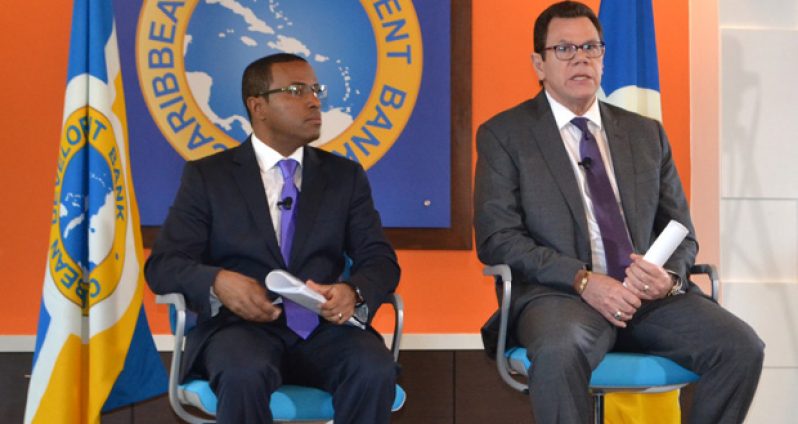By Alva Solomon
WHILE the Caribbean economy is currently in recovery mode after a topsy-turvy 2015, Guyana‘s is expected to grow somewhat this year, thanks to a projected rise in gold prices and continuous mining activity.This is according to the Caribbean Development Bank’s (CDB) 2015/2016 Economic Review, which the bank unveiled at its annual press conference yesterday at its headquarters in St Michael, Barbados.
The bank says that in 2015, output from agriculture, manufacturing and other service industries rose. It said that in Guyana, which is one of 19 borrowing member countries (BMCs), the economy experienced significant contractions during the first half of last year in the production of gold and bauxite. This was attributed to falling prices as well as a drop in construction activity.
The bank said that activity in the mining sector rebounded sometime around June, and this was particularly attributed to a new gold mine coming on stream. In addition, rice and sugar production grew and this drove an increase in the manufacturing sector.
According to the report, the Caribbean economy experienced a difficult year in 2015 and that was as a result of the global effects of other world economies impacting on the region.
CDB President Dr. Warren Smith told the media conference of local and regional journalists, that if one were to examine the metric of economic growth, 13 of the 19 bank’s borrowing member countries should grow faster in 2016 than they did in 2015, but “two of the stronger credits, Trinidad and Tobago and Suriname, would experience negative growth in 2016.” Interestingly, he noted, all the services-dependent economies should grow, even if very marginally.
He said that one could conclude that Caribbean economies are in recovery mode. “And that would be a fair comment, except that it is occurring at a time of great uncertainty in what is emerging as a somewhat topsy-turvy external environment,” he said.
Dr. Smith provided a financial breakdown of the bank’s expenditure for 2015. He told the media that last year the CDB approved 12 capital loans, three policy-based loans (PBLs) and 62 technical assistance interventions. Total approvals reached US$292M, an increase from US$270M in 2014 and total disbursements last year amounted to US$160 million.
He said that loans totaling US$262M were transacted with 10 countries, the largest beneficiaries being Antigua and Barbuda, Belize and Grenada.
The bulk of the financing was targeted at investments to strengthen and modernise social and economic infrastructure, to improve environmental management and disaster risk management, to build climate resilience while promoting energy efficiency, and renewable energy and also to encourage private sector development and improvements in governance.
According to Dr. Smith, infrastructure development plays an important role in enhancing the business environment, increasing access to employment opportunities and reducing poverty. He listed several financial facilities which will be accessible by member countries this year.
This included a £300M UK-Caribbean Infrastructure Fund (UK-CIF) fund. Beneficiary countries, including Guyana, will be able to access grant financing for new infrastructure such as roads, bridges and port development – critical drivers of economic growth and employment creation.
CDB Economic Director, Dr. Justin Ram told the media conference of local and regional journalists that the global economy fell from 3.4% in 2014 to 3.1% in 2015. He said the main reason for that slow movement was China’s economic issues which along with other events kept commodity prices low and this he noted, impacted the exporters of those products.
According to the bank, last year characteristics other than the region’s reliance on overseas markets, emerged and those included vulnerability. The bank pointed to natural disasters, including Tropical Storm Erika which ravaged several territories, including Dominica, which was hard hit.
The bank noted that the region needed to address its vulnerability, which has had an adverse impact on sustainable growth.
Looking ahead, the CDB remains optimistic but forecasts 2016 to be a year of significant uncertainty as the recovery remains fragile. The bank called on member states to be dynamic, export-oriented, competitive, inclusive, diverse, and have environmentally resilient economies in order to reach growth on par with other developing nations.
The bank noted that key drivers along the route included private sector-led growth, an educated and flexible work force, and regional integration which would maximize gains as well as the governments to act as facilitators and efficient regulators.





.jpg)








